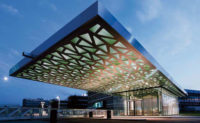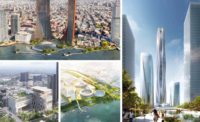Borrowing strategies from both Europe and India, MVRDV designed Future Towers to attract a broad range of homebuyers in the rapidly developing city of Pune in western India. The project’s bold formal moves—arranging 17-, 20-, and 30-story wings around hexagonal courtyards and punching variously sized voids through the facades—derive from the Amsterdam-based firm’s design DNA, and its mix of income groups follows a Dutch model of housing diversity. But the narrow width of the wings and the particular layouts of the 1,068 apartments acknowledge local preferences. The result is an intriguing hybrid that stands out in a progressive 400-acre development.
Additional Content:
Jump to credits & specifications
Located 90 miles southeast of Mumbai, Pune has leveraged its concentration of higher-educational institutions and its role as a leader in India’s automobile-manufacturing sector to become a technology hub drawing young professionals from around the country. Its altitude of 1,800 feet and its manageable size of 3.4 million people make it a more comfortable alternative to the country’s teeming mega-cities. But, as in the rest of India, the government hasn’t been able to build the modern infrastructure needed to support growth. So, in 2005, the state of Maharashtra, which includes Pune, passed legislation to encourage private developers to build so-called “townships” of at least 100 acres. In exchange for tax relief and development rights, the companies must build all of the power, water, and sewer infrastructure, as well as roads, schools, and hospitals needed for residents.
Pune-based City Corporation Limited began constructing Amanora Park Town in 2007. Set on what had been farmland, the town is now home to more than 10,000 people, most living in high-rise buildings, but some in single-family villas. A 2.85 million-square-foot shopping center, a fire station, a post office, two primary schools, a high school, a Neoclassical clubhouse with a domed entry rotunda (trying to channel the spirit of Brunelleschi), two artificial lakes, a 26-acre central green, an outdoor amphitheater, and four community centers are spread out around the development.
A fiber-optic cable network and digitally controlled infrastructure provide a sophisticated communications and management network, while systems for recycling non-degradable waste, composting wet waste, and harvesting rainwater make it more environmentally sustainable than most developments in the U.S.
Most of the apartment buildings at Amanora Park cater to a particular income group, though the township as a whole must provide 10 percent of its units to low-income families and set aside land on the property for the farmers who had lived there to build their own homes. Jacob van Rijs, the MVRDV principal in charge of Future Towers, convinced the client to mix units for low-, middle-, and upper-income residents in his firm’s project and integrate them within the nine different wings of the building. “We imported the notion of creating a diverse social organization,” says van Rijs.
MVRDV won the project in an invited competition that included the venerable Hong Kong firm P&T, which has designed other apartment buildings at Amanora Park, and several Indian offices. The invitation came after van Rijs had lectured in India and MVRDV had done preliminary schemes for other projects in India that did not get built. It is MVRDV’s first in India to be completed, though the firm has another currently in construction and two others in design, as well as two more slightly smaller phases of Future Towers.
Asked by the client to create a “vertical city” that would be “an architectural marvel,” MVRDV developed a scheme inspired by landscape formations with “peaks and valleys, canyons and bays, grottoes and caves,” says van Rijs. In northern Europe, most apartment buildings have compact footprints to reduce perimeter surfaces and the need for insulation. But in the hot climes of India, architects usually maximize perimeters to increase natural ventilation. Even in Amanora Park, which has modern power generators for air-conditioning, homebuyers expect naturally ventilated rooms, says van Rijs. As a result, he and his team designed Future Towers as a snaking line of nine 60-foot-wide wings with apartments on either side of a central corridor.
The concrete-frame structures wrap around courtyards defined by a partially expressed hexagonal grid. MVRDV used just four vertical circulation cores, with each one servicing three wings and acting as a knuckle connecting different pieces of the project. Rather than enclosing the cores, the architects opened them to light and air.
Faced with Indian building codes that require refuge spaces where people can gather in case of fire or emergency, MVRDV turned these spaces—called “scoops”—into defining elements. Varying in height from one to three stories, they act as open-air rooms for different activities (yoga, miniature golf, and socializing) and types of residents (toddlers, teens, and sports fans). MVRDV didn’t control the murals on the walls wrapping these spaces, but did select the colors.
At the ground level, MVRDV cut trapezoidal voids where the wings connect to the cores, allowing residents (and fire trucks) to move from the street-facing courtyards to the central green. Painted in vibrant colors such as turquoise and mango, they serve as large, shaded places to gather when it rains or the sun is too strong. The complex sits on a two-story plinth, with parking under all of the wings and retail facing the most active pedestrian areas.
MVRDV didn’t design the apartments but created a flexible system that allows the developer to vary the size of the units, which are for sale, depending on market demand. Every floor can include a mix of studio and one-, two-, three-, and four-bedroom apartments, with the largest ones usually at the end of each wing where they have large terraces on the sloped side of the building. Each unit gets an outdoor space—either a balcony or a terrace. As is typical in India, bathrooms and kitchens overlook airshafts containing plumbing lines.
In such a large complex, navigating the various cores and long corridors can be tricky for visitors. But the architects shrewdly placed the scoops along the corridors to bring in daylight and break down distances. The scoops and the courtyards also help create a series of neighborhoods and provide a more intimate scale to the project.
With its distinctive profile and punctured facades, Future Towers stands as a visual landmark within the sprawling Amanora Park. Just as important, with young professionals living side by side with extended families and lower-income residents, it serves as a laboratory of social diversity.
MVRDV principal Winy Maas will be speaking at RECORD's annual Innovation Conference on Thursday, November 1.
For more details: http://www.arinnovationconference.com/
CreditsArchitect: MVRDV—Jacob van Rijs, partner in charge
Engineering: Neilsoft (m/e/p); J+W (civil, structural) |
|














Post a comment to this article
Report Abusive Comment